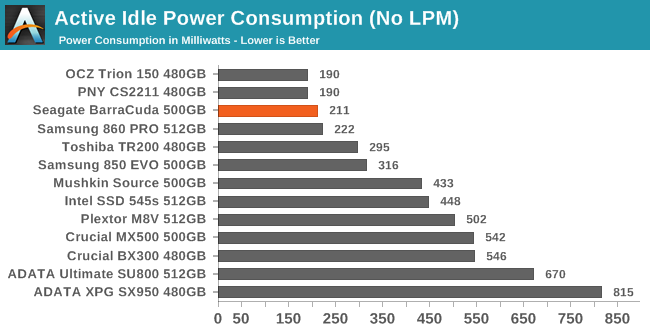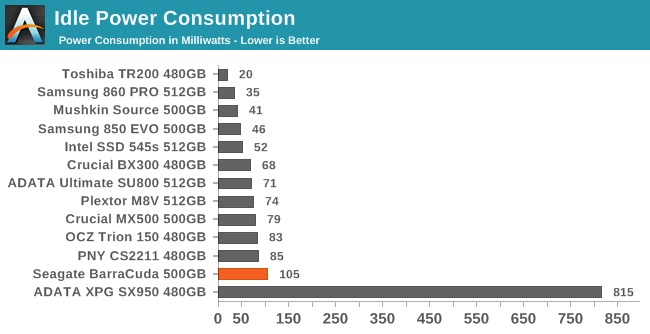The Seagate BarraCuda (500GB) SSD Review: Getting Back In The Game
by Billy Tallis on December 7, 2018 8:00 AM ESTIdle Power Measurement
SATA SSDs are tested with SATA link power management disabled to measure their active idle power draw, and with it enabled for the deeper idle power consumption score and the idle wake-up latency test. Our testbed, like any ordinary desktop system, cannot trigger the deepest DevSleep idle state.
Idle power management for NVMe SSDs is far more complicated than for SATA SSDs. NVMe SSDs can support several different idle power states, and through the Autonomous Power State Transition (APST) feature the operating system can set a drive's policy for when to drop down to a lower power state. There is typically a tradeoff in that lower-power states take longer to enter and wake up from, so the choice about what power states to use may differ for desktop and notebooks.
We report two idle power measurements. Active idle is representative of a typical desktop, where none of the advanced PCIe link or NVMe power saving features are enabled and the drive is immediately ready to process new commands. The idle power consumption metric is measured with PCIe Active State Power Management L1.2 state enabled and NVMe APST enabled if supported.


The active idle power consumption of the Phison S10 controller has always been pretty good, though the Seagate BarraCuda draws a bit more at idle than some of the older S10 drives we've tested. When SATA link power management is enabled and the drive is put to sleep, the BarraCuda's power consumption is only cut in half and every other drive with working power management comes out ahead.

The Seagate BarraCuda had relatively poor idle power management, so it's appropriate for it to have one of the quickest wake-up latencies, slightly faster than the two older Phison S10 drives featured here. The BarraCuda wakes up seven times faster than the fastest Silicon Motion-based drive, and 26 times faster than the Toshiba TR200 that uses Phison's DRAMless S11 controller. The BarraCuda should definitely be used with the OS configured for the most aggressive drive power management, because the performance impact is minimal.










39 Comments
View All Comments
Hulk - Friday, December 7, 2018 - link
Fantastic review as always. Thanks for your hard work.But I'm curious as to why the Samsung EVO 860 isn't in the benchmarks. It was recently selling for under $130 (not back at $150) and seems to be the benchmark to which most drives in this category should be compared?
Gasaraki88 - Friday, December 7, 2018 - link
The 850 EVO and 860 EVO are very similar in performance.Samus - Friday, December 7, 2018 - link
The problem for Samsung's consumer market is they've been making drives that max out the capabilities of SATA for 5 years. There just isn't much more room to improve.And the problem for Samsung's prosumer market is the WD Black NVMe is an overall better value than the 970 NVMe, ESPECIALLY in mobile where the 970's (even the EVO) are so power hungry they constantly throttle in laptops, while reducing battery life.
Samsung is riding on reputation right now. Superior products in the SATA space are irrelevant because at the high end you wont notice a real difference between SATA drives. And in the NVMe space, there are plenty of players on par with Samsung.
zodiacfml - Monday, December 10, 2018 - link
I used to think that SATA is dumb for recent SSDs. However, I noticed that it is only for sequential workloads which can be left running in the background. SATA still has a lot of life for SSDs.The 2.5" form factor is still dumb though. It is huge waste of space and materials.
Can't they make the case the size of the PCB using only the first pair of screws for mounting?
derekullo - Monday, December 10, 2018 - link
The reason this was done was to safe on space knowing that eventually they would deployed in laptops.Another reason was that when ssds were first being released with SLC, they were incredibly expensive and nobody could afford to buy your 1 Terabyte 3.5" drive filled to the brim with SLC nand. Of course we can afford it now ...
derekullo - Monday, December 10, 2018 - link
save on space* be deployed*Billy Tallis - Friday, December 7, 2018 - link
My smallest 860 EVO sample is 1TB, and I didn't want to put that on the graphs as the only drive of that capacity. Performance generally increases with drive capacity, so the 1TB would exaggerate the performance advantage of the 860 EVO over the BarraCuda (and probably slightly understate the efficiency advantage). You can make the comparison with our Bench tool if you're interested: https://www.anandtech.com/bench/product/2201?vs=21...Hulk - Friday, December 7, 2018 - link
Okay that makes sense.Death666Angel - Friday, December 7, 2018 - link
2.5" SATA SSDs should just become M.2 SATA SSDs with a caddy. :)Dragonstongue - Friday, December 7, 2018 - link
not everyone has m.2 on their boards and many of those boards overheat the drive in that slot anyways....t each own, "slow" drives are best kept as full out SATA sized drive (which vast majority are 2.5" anyways. the samsung 8/9xx are "unique" in that the pcb housing the memory chips etc is quite small compared to many so they "easily" put on a m.2 "gum stick"